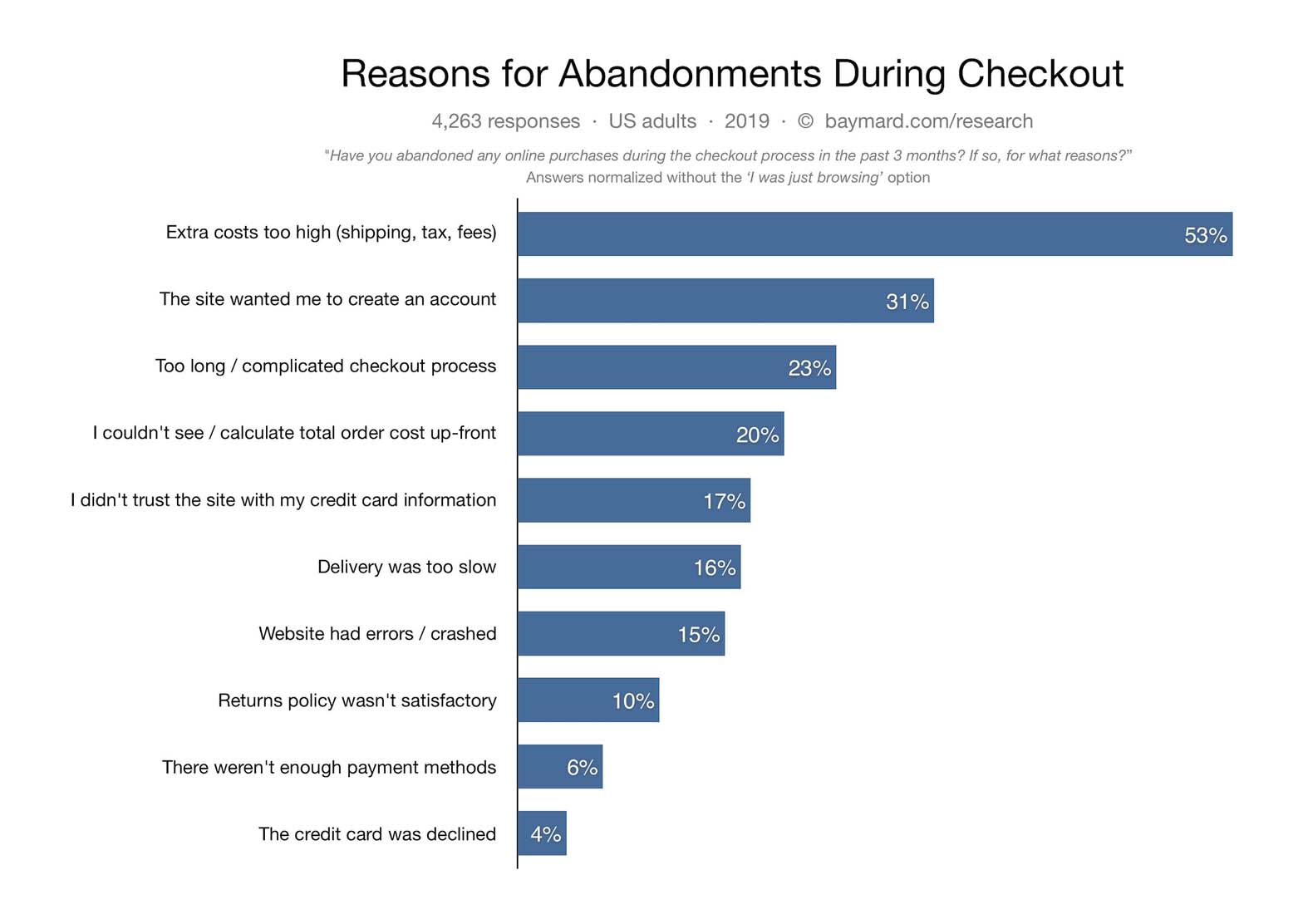
Picture this: a customer browses a grocery store, selecting an item or two out of each aisle and putting it in their cart. They then make their way to the checkout area. Once there, they abandon their cart, leaving it behind as they walk out the door without making a purchase.
Hard to imagine, isn’t it?
Yet, this occurrence is common in the ecommerce marketplace. Anonymity and ease make comparison shopping online an obvious choice for consumers and businesses alike. This has implications for internet and cloud-based subscription businesses such as software as a service (SaaS).
According to a 2019 study by Baymard Institute, the most common reason shoppers cite for online cart abandonment is “I was just browsing/not ready to buy.” This reasoning accounts for 58.6% of abandoned carts.
If you’re experiencing a high cart abandonment rate it may be time to dig a little deeper. There are many additional reasons for cart abandonment. And identifying weaknesses in your checkout process can be the difference between acquiring customers and missing out on revenue.
Why do ecommerce customers abandon carts?
While comparison-shopping culture has certainly hit ecommerce businesses hard in the carts, it’s not the only culprit. Here are ten more reasons Baymard’s study identified for cart abandonment.
source: Baymard Institute
What can ecommerce businesses do to reduce cart abandonment?
From the reasons above, it’s clear there are a few things ecommerce businesses can change about their checkout process to increase customer acquisition. Let’s start from the top.
- Reduce surprises like extra costs and total order cost. “Extra costs too high” and “I couldn’t see/calculate total order cost up-front” claim the #1 and #2 spots respectively on Baymard’s list. When it comes to spending money, nobody likes being surprised. Add on the commitment of a subscription-based product or service with recurring charges that last months or years, and it’s easy to see why customers prefer clarity in pricing every step of the way. To increase transparency and reduce the shock of extra charges, make sure the product cost and any additional charges such as taxes and fees are clearly stated on the product page. If relevant, include a total cost calculator in the shopping experience as items are added to the cart. And for businesses that ship, consider free shipping, especially for orders over a certain size.
- Streamline the account creation and checkout processes. Coming in at #2 and #3, having to create an account and ensure long or complicated checkout processes claim the next spots on the list. Most ecommerce businesses rely on account creation, making an account-free, guest checkout option unlikely or impossible—especially for subscription-based businesses. However, this doesn’t mean you can’t simplify the account creation process to make it more attractive. Enabling new subscribers to create an account through Facebook, Google, or Apple is easier and likely more secure.As for checkout, complicated processes requiring multiple pages are tedious. Shoppers can lose interest and give up. If your checkout requires multiple pages to load for reviewing the cart, entering shipping information, entering billing information, and confirming the purchase, it’s probably too long. That’s part of the reason why Amazon patented 1-Click purchasing in 1999, and why you’d be wise to implement it in your ecommerce business now that the patent is expired.
Lastly, make sure your site is capable of handling checkout. At #7 on Baymard’s list, errors and site crashes shouldn’t be bogging down the process and costing you customers.
- Step up your payment management. Reasons #5, #9, and #10 on the list all have to do with one thing: payment. When it comes to money, customers want to be sure about a lot of things, such as:- how much they’re spending
– what exactly they’re getting, and
– that their payment information will be kept secure.They also want easy payment, and you should want to make it easy for them to pay, as well!For these reasons, it’s worth considering investing in agile billing software, especially if your business operates on a recurring billing model.Look for software that meets the highest standards of PCI compliance, can handle multiple payment methods and gateways, and includes advanced dunning management capabilities. This means failed credit cards will be automatically retried. Over time, dunning management even reduces customer churn as expired subscriber cards are automatically updated.
Robust subscription billing platforms reduce customer anxiety and failed payments. What’s not to love?
- Consider data-driven cart abandonment reduction tools. Shipping and return policies are the only issues left on Baymard’s list, meaning some businesses may have room for improvement in those areas. For ecommerce businesses, there are also a few other tricks available to mitigate cart abandonment.For example, exit popups can catch a shopper before they close a page. Display a coupon code here, and you may just recover the cart and acquire a new customer. Keeping a cart visible throughout the shopping experience is helpful, as well. This reminds shoppers they found a product interesting enough to put it in their cart.Finally, save the cart even if customers leave, then circle back with an email or targeted ad. If a customer revisits, their items should be there waiting for them.
Combat cart abandonment with a multifaceted approach
Cart abandonment is common, and there are many different reasons for it. Yet, there are just as many ways to reduce it and acquire more customers. From transparency and streamlining processes to considering agile billing software and abandoned cart tools, the opportunities to boost your customer acquisition by developing a seamless checkout experience are abundant.
Take the time to identify your customers’ checkout pain points, and you’ll be on your way to choosing the right solutions for your ecommerce business.











